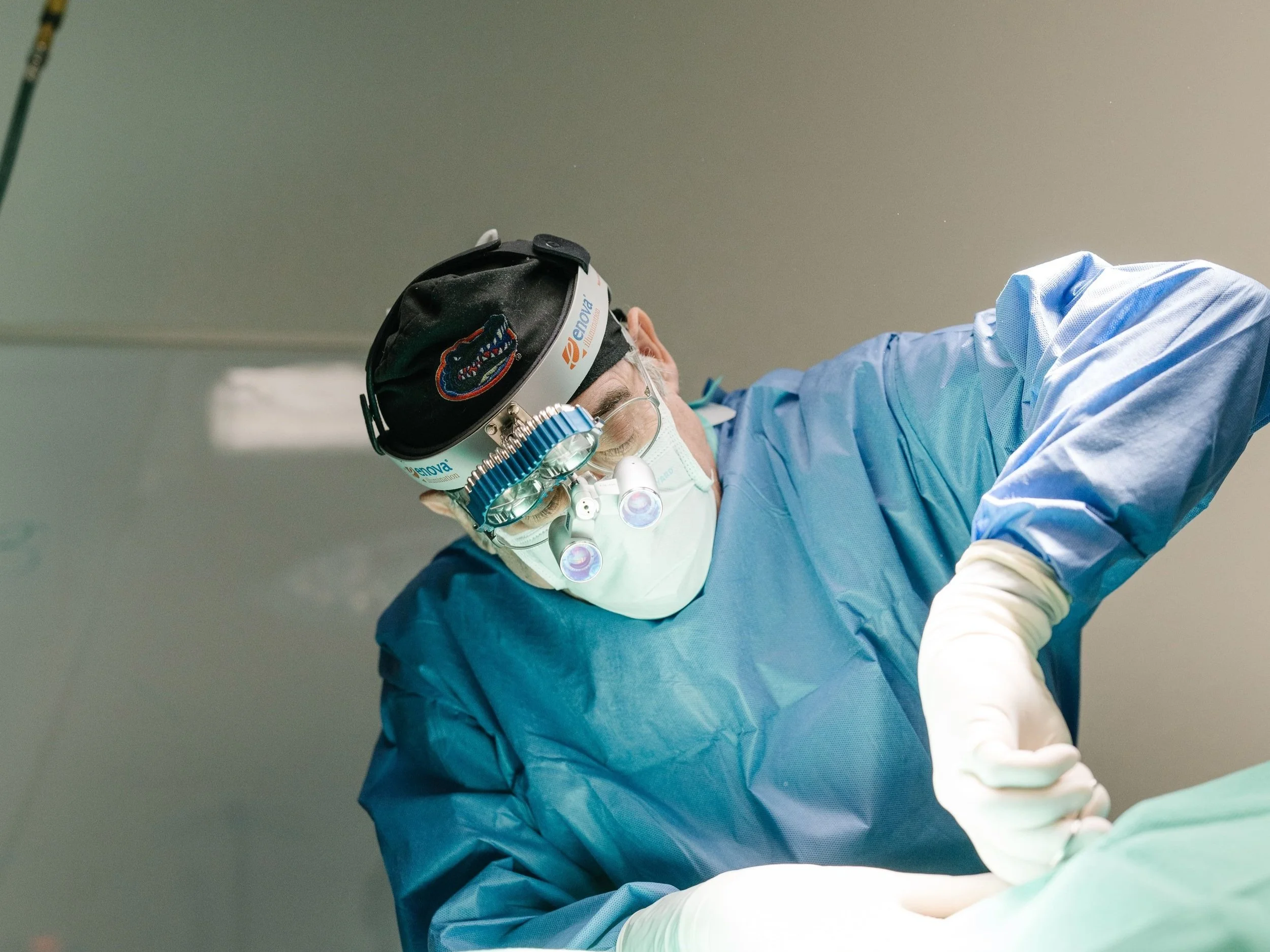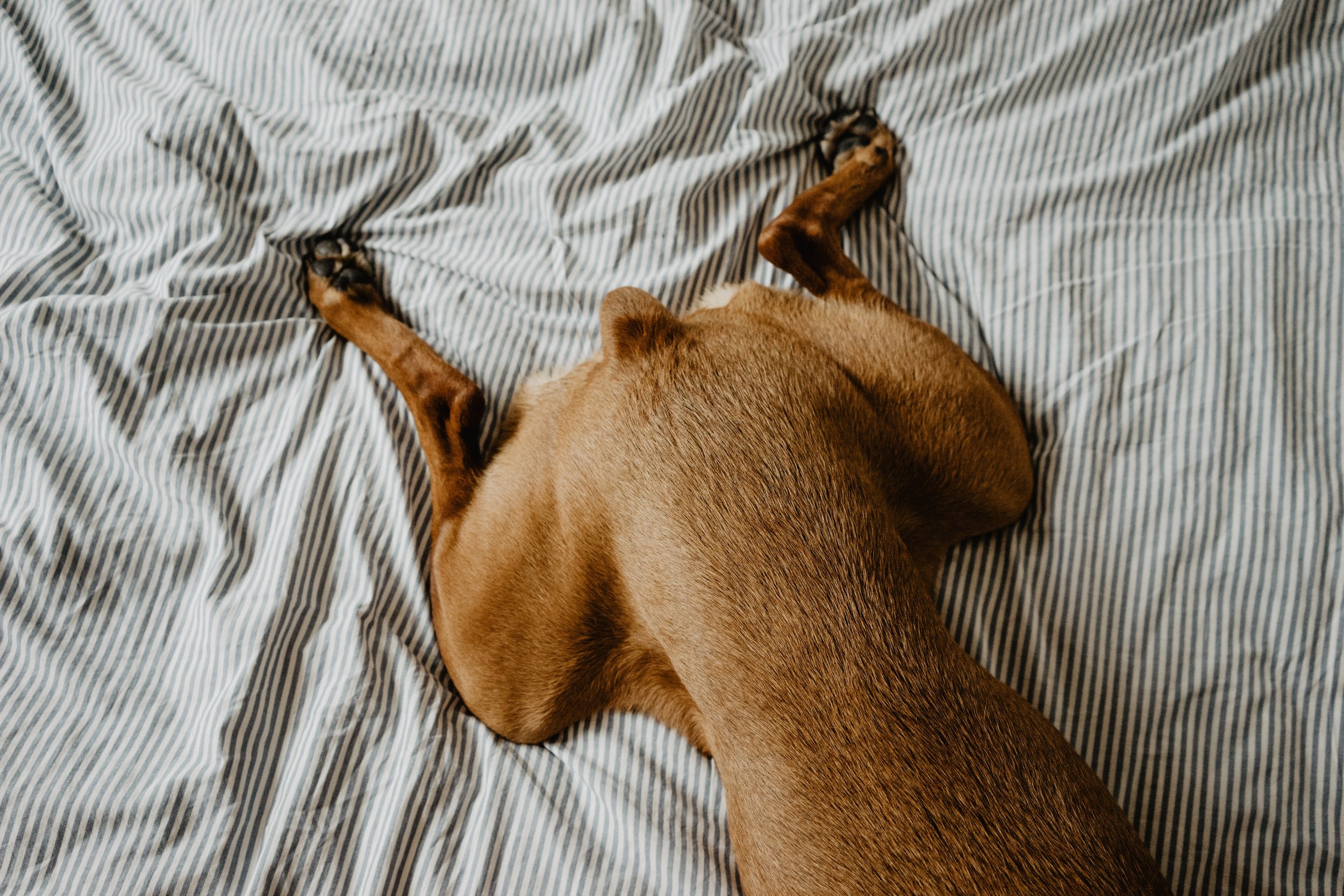CCL Surgery in Dogs: An Effective Surgery for Painful Joints in Dogs
As our pets age, health problems are bound to crop up for them. It’s a part of life. But that doesn’t make it any easier when they experience an injury or life-threatening illness. No one wants their pet in pain. It’s distressing and a cause for concern.
The first step in addressing pet-related injuries is to know what they are. The second step is understanding the treatments available for your furry friend. And the third step is getting the best care possible from knowledgeable doctors.
Dr. Gainsburg performing veterinary surgery.
In this article, we explain knee injuries in dogs - specifically, cranial cruciate ligament (CCL) tears and what to do when your dog is diagnosed with a CCL injury.
CCL injuries are the most common knee injuries in dogs.[1] So it’s important to be prepared for when this type of injury happens. And with the right veterinarian team, you can get answers and a proper plan in place for a CCL surgery in dogs.
What is CCL in dogs?
The knee joint in your dog is made up of ligaments, tissues, and bones. There are two ligaments in a dog’s knee. They are called the cranial cruciate ligament (CCL) and the caudal cruciate ligament.
The CCL in dogs is very similar to the anterior cruciate ligament (ACL) found in humans. These ligaments are called cruciate because they crisscross over one another inside the knee, like an ‘X’ made of cartilage.
The CCL works to stabilize the lower leg to the upper leg. It acts as a kind of tape and helps the knee joint hinge and move properly. The knee joint also holds the meniscus, which acts as a cushion for all the parts inside the knee.
What is CCL injury in dogs?
A CCL injury happens when the CCL tears, ruptures or degenerates over time. This injury is similar to an ACL tear commonly experienced by athletes. Unlike humans though, a tear of the CCL in dogs is rarely the result of a traumatic injury.
Animals tend to experience CCL as a “disease”. The ligament weakens over time due to genetic or environmental factors, and/or inflammation in the joints. The weakened ligament may partially or completely rupture following activities such as running or jumping.[2]
When this CCL is compromised, the tibia (shin bone) slides forward, closer to the femur (thigh bone). If your dog has a torn ligament, it can’t walk and experiences a lot of pain. In some cases, your dog may become immobile or lame, depending on the severity of the tear.
As with all ligaments, a ruptured CLL shortens and never fully recovers. There’s hope though! Your vet will help make a diagnosis and present treatment options depending on the seriousness of the CCL injury. With new technology today, there is hope for your dog to live a normal, healthy, and pain-free life after a CCL injury.
CCL injury affects the knee joints in dogs.
How common is CCL injury in dogs?
The condition leading to CCL injury is often present in both knees, and about 30- 50% of dogs will rupture both CCLs within 1-2 years of each other.[2]
There are also certain breeds more prone to developing a CCL injury in their lifetime. Some breeds that commonly experience CCL issues are:
Labrador Retriever
Newfoundland
St. Bernard
Bichon Frise
German Shepherd
Rottweiler
It’s good to know if your pet has a higher chance of developing a CCL injury because of genetics. With this information, you can better plan for the future of your pet’s health. If you have a dog that is more prone to CCL injuries, pet insurance is recommended. Insurance is helpful and can manage costs associated with potential health issues.
How to Diagnose CCL Injury in Dogs
Once your dog begins showing signs of knee pain, lameness, or immobility you want to call your vet immediately. Your vet will ask questions about the signs and symptoms and perform tests to inform a diagnosis.
A thorough examination and X-rays provide a lot of initial information for you and your vet. X-rays are a type of diagnostic imaging used to rule out other potential causes of your dog’s knee pain. This type of imaging also helps locate and understand the extent of arthritis and scarring, if present.
A joint test called the ‘cranial drawer test’ is also routine and measures the level of instability in your dog’s knees. During this test, your vet will feel around your dog’s knee, looking for abnormal movement, thickening inside the knee, or “tibial thrust” (displacement of the tibia).[2]
How do you treat a CCL injury in dogs?
According to VCA Hospitals research, “Young dogs weighing less than 22 lbs may heal without surgery, provided they go on severe exercise restriction and cage rest for six weeks. Dogs over 22 lbs usually require surgery to stabilize the knee. Unfortunately, most dogs will eventually require surgery to correct this painful injury.”[4]
Surgery helps stabilize the knee and is the best option for dogs with a CCL injury, especially large dogs. Without surgery, your dog will experience permanent damage.
CCL Surgery in Dogs
Your vet will help you make the best decision for surgical treatment based on their knowledge of your pet’s health and history. There are three well-known and effective procedures for CCL surgery in dogs:
Tibial Plateau Leveling Osteotomy (TPLO)
Tibial Tuberosity Advancement (TTA)
Lateral Fabellotibial Suture (LFS)
In general, TPLO surgery has an excellent success rate (between 90-95%) and is considered superior to other types of CCL surgery in dogs.[5] TPLO surgery is more often recommended for large and giant dog breeds. But it is even used in cats, so dogs of all breeds and ages benefit from this procedure.
TPLO Surgery for Dogs
Surgical procedures in the veterinary world require an educated and experienced team of veterinary surgeons. Outpatient imaging centers, like Sage Veterinary Imaging, have specialty surgeons on staff that can perform this technical procedure.
At Sage Veterinary Imaging, our team of radiologists uses X-rays to help locate the disease and plan TPLO surgery. The goal of the procedure is to remove damaged ligaments and restructure the knee so your dog can walk properly again and without pain.
During the surgery, your pet is under anesthesia. The surgeon repositions the load-bearing area of the knee and secures it into place using a specially-designed bone plate and screws. The knee joint is then stable. A bandage is applied over the incision site for protection.[2]
After a successful surgery, X-rays are used again to show the new angle of the shin and how the position of the screws and plates is functioning. For most dogs, this surgery requires an overnight stay in the hospital, and your pet receives painkillers and antibiotics.[2]
Post-op recovery is recommended after CCL surgery in dogs.
Post-Operative Recovery for CCL Surgery in Dogs
If you want the best outcome, your pet needs a substantial recovery period following extensive surgery like TPLO or CCL surgery in dogs. This is a rehabilitation period and helps the bone and knee to heal. Post-op recovery can last from 8 to 12 weeks and requires rest and relaxation for your pup.
A lot of what you do as an owner during this period can speed up the recovery process and ensure your dog has the best chance of a pain-free future. For the first two weeks after your dog returns home, here are some tips to help your dog fully heal:
Ice it: Ice helps reduce swelling.. Do this 2-3 times a day, up to 20 minutes, with an ice pack or cubes wrapped in a towel. A bag of frozen veggies works too! This is most important for the first 72 hours after surgery.
Keep it calm: Reduce noise and disruptions. It’s an important period for your dog, and they need their energy to heal.
Keep it clean: The incision site should stay dry and clean at all times after the bandage is removed. If it looks like it’s not healing well, call your vet.
Keep it comfy: Make sure they are comfortable. Use the medications your vet has prescribed. If the pain seems to be getting worse, call your vet.
Limit activity: Keep them in their crate or restrict them to one area of the home with a circular fence to rest.
Use a leash: This prevents falls and keeps them under supervision. Slings and harnesses are good for bigger dogs to help pull them up to walk. Any movement should be assisted by you!
You also want to avoid heavy exercise, roughhousing, climbing steps, and jumping. These things will ensure your pup is ready to take on the rest of the world in a couple of months.
After two weeks, your dog’s daily activities are easier to perform and routine once again. Your dog’s walks can be a little longer, and by the end of the eighth week, two 20-minute walks a day are expected and normal activity for this stage.[2]
At eight to ten weeks, X-rays are used (yep, again!) to see how the knee joint is healing. Heavier exercise and more playtime are possible at this stage in your dog’s recovery.
Watching your dog’s weight and ensuring they are getting enough low-impact exercise, walking, and running are preventative measures you can take to help prevent further CCL injuries or joint damage.
Pain management is a final and important part of the overall health and well-being of your pet. At Sage Veterinary Imaging, we can help you understand what to do next when your dog needs CCL surgery and how to navigate the recovery and pain management process.
Sage Veterinary Imaging in Sandy, Utah
Sage Veterinary Imaging is a Leader in MRI, CT, and Finding Answers For Your Pet
Sage Veterinary Imaging has been operating in Round Rock, Texas for 8 years. With a new location in Sandy, Utah, and more on the way, we are here to help get answers for your pet.
When your pet is acting differently and showing signs of distress, it may need a CT or MRI scan. The radiologists, surgeons, and veterinarians on our team can see more of your pet’s complete health profile - with twice the resolution and in half the time.
Ultimately, we aim to make the most informed decisions to help your pet. And we know you only want the best for your pet. For more information on where to find an MRI or CT scan for dogs in Texas or Utah, go to our Contact Us page to learn more.
Sources:
https://vcahospitals.com/know-your-pet/cranial-cruciate-ligament-repair-tibial-plateau-leveling-osteotomy-tplo
https://smallanimal.vethospital.ufl.edu/clinical-services/surgery/orthopedic-surgery/cranial-cruciate-ligament-rupture/
https://vcahospitals.com/know-your-pet/cranial-cruciate-ligament-repair-tibial-plateau-leveling-osteotomy-tplo
https://vcahospitals.com/know-your-pet/cruciate-ligament-rupture-in-dogs#:~:text=Dogs%20weighing%20less%20than%2010,to%20correct%20this%20painful%20injury.
https://animalcarectr.com/what-is-the-success-rate-for-tplo-surgery-in-dogs/




